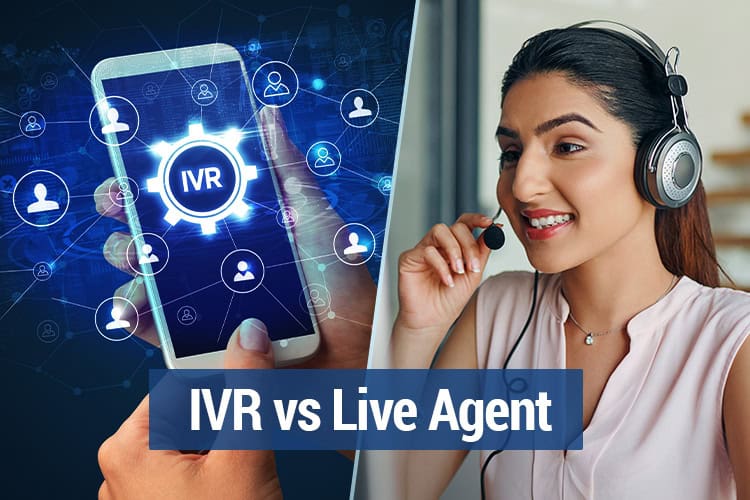Great customer service goes beyond answering calls—it’s about efficiency, quick problem-solving, and offering customers choices. The key isn’t IVR or live agents alone but using both effectively. Automation handles routine tasks, while human agents provide a personal touch. The challenge is balancing both to ensure efficiency without compromising customer satisfaction.
Let’s break down IVR vs. live agents, the pros and cons of each, and how businesses can integrate them effectively.
- Balance IVR & Live Agents for efficiency and customer satisfaction.
- IVR automates routine tasks but can frustrate customers with complex issues.
- Live agents handle complex and emotional needs but are costly to scale.
- Smart IVR integration enhances experience with AI, CRM, and call-back options.
Understanding IVR: The Foundation of Automated Call Handling
Interactive Voice Response (IVR) is a telephony technology that allows customers to interact with an automated systembefore speaking with a live agent. It provides menu options that guide callers to the information they need using either keypad inputs or voice recognition.
Companies use IVR systems to automate routine inquiries, such as:
- Checking account balances or order statuses
- Scheduling appointments
- Making payments
- Getting answers to FAQs
By handling these tasks automatically, IVR significantly reduces call center workload and ensures faster response times for simple requests.
How IVR Works
- A customer calls in and is greeted by a pre-recorded or AI-driven voice system.
- The IVR presents a menu with different options based on the nature of the inquiry.
- The caller selects an option (either through voice or keypad), directing them to self-service information or routingthem to a live agent if needed.
- If escalation is required, the IVR transfers the call to the appropriate department or agent.
When configured properly, IVR can streamline communication and save valuable agent time. However, its effectiveness depends on how intuitive and well-structured the system is.
“A poorly designed IVR frustrates customers, but an intelligent, well-structured IVR enhances the experience. The goal isn’t to replace human agents—it’s to make customer interactions smoother, faster, and more effective.” – Christian Montes Executive VP of Client Operations, NobelBiz
Pros vs. Cons of IVR: An Overview
While IVR brings clear advantages, it also comes with limitations that businesses must consider.
Pros of IVR |
Cons of IVR |
|---|---|
Scalability Without Increasing Costs• IVR can handle thousands of calls simultaneously without hiring additional agents.• Businesses can easily scale operations to meet seasonal spikes or unexpected surges in call volume. |
Lack of Human Interaction• Customers with complex issues may struggle with IVR’s structured responses.• Voice recognition can misinterpret customer inputs, leading to frustration. |
Cost Savings• Automating routine inquiries means fewer agents are required, reducing payroll costs.• AI-powered IVR solutions minimize agent workload, allowing teams to focus on more complex issues. |
Potential for Customer Frustration• Overcomplicated menus can create a poor experience. If customers struggle to find what they need, they may abandon the call altogether.• Some customers repeatedly press “0” to reach an agent, bypassing IVR entirely. |
Efficient Call Routing• IVR ensures calls reach the right department or agent, eliminating unnecessary transfers.• Integrating IVR with a CRM system allows personalized routing based on customer history. |
Limited Flexibility• IVR works well for predictable interactions but cannot handle emotional or highly nuanced conversations.• It may struggle with unexpected customer inquiries that don’t fit predefined menu options. |
Consistent Customer Experience• Unlike human agents, IVR never gets tired or inconsistent.• Provides 24/7 availability, ensuring customers can get assistance even after hours. |
Understanding Live Agents: The Human Touch in Customer Service
While IVR enhances efficiency, live agents provide adaptability, emotional intelligence, and problem-solving skills that automation cannot replicate. Customers dealing with billing disputes, technical issues, or urgent concerns often prefer speaking with a real person who can adjust their approach in real time.
Live agents excel in handling:
- Complex inquiries that require critical thinking
- Emotional or sensitive customer interactions
- Technical troubleshooting that demands back-and-forth dialogue
- Situations where personalized support is required
In industries like healthcare, finance, and insurance, where customer issues can be high-stakes, human support is often non-negotiable.
Pros vs. Cons of Live Agents: An Overview
Pros of Live Agents |
Cons of Live Agents |
|---|---|
Ability to Handle Complex Issues• Unlike IVR, agents can adapt responses in real time based on the conversation.• They can ask clarifying questions to fully understand and resolve a customer’s concern. |
High Operational Costs• Hiring, training, and retaining live agents is expensive, especially for businesses handling large call volumes.• Unlike IVR, which runs 24/7 at no extra cost, live agents require salaries, benefits, and infrastructure. |
Emotional Intelligence & Personalization• Agents can detect frustration, urgency, or confusion and adjust their tone accordingly.• They can provide reassurance and build relationships, which IVR cannot do. |
Scalability Challenges• Live support doesn’t scale easily. If call volumes surge, businesses must hire more agents, which takes time.• Workforce management must be optimized to prevent agent burnout while maintaining coverage. |
High Success Rate for Resolution• Live agents have higher first-call resolution rates than IVR systems.• They can make judgment calls and solve unique issues without rigid scripting. |
What’s the Ideal Mix of IVR and Live Agents?
Since IVR and live agents serve different functions, the most effective solution combines both. The goal is to let IVR handle straightforward interactions, while seamlessly escalating more complex issues to live agents.
“Live agents can’t scale indefinitely, but IVR can. A well-optimized IVR system ensures businesses can handle peak call volumes without hiring massive teams. The trick is knowing which interactions should stay automated and which need a human touch.” – Michael McGuire Chief Sales Officer Nobelbiz
How to Leverage IVR Effectively
- Use IVR for frequently asked questions (account balance, store hours, appointment scheduling).
- Offer call-back options to prevent long wait times.
- Implement speech recognition and AI enhancements for a smoother experience.
How to Leverage Live Agents Where It Matters
- Assign agents to high-value customer interactions (VIP clients, major disputes).
- Use agents for technical support and emotionally sensitive conversations.
- Provide blended agent assistance, where agents monitor IVR interactions and step in when needed.
Brayan Carpio
Choosing The Right Solution For Your Contact Center – NobelBiz’s IVR System Solution
NobelBiz offers a next-generation IVR system designed to:
✅ Automate customer interactions without frustration
✅ Route calls to the right agents seamlessly
✅ Integrate with CRM systems for personalized service
✅ Handle high call volumes efficiently while reducing costs
Final Thoughts: Finding the Right Balance
IVR and live agents each serve a purpose, but the best customer service strategy combines both. IVR streamlines routine interactions, reducing costs and wait times, while live agents handle complex issues with a personal touch. The key is seamless integration—and that’s where NobelBiz excels.
With NobelBiz’s Cloud Contact Center Solutions, businesses can implement a smart, flexible IVR system that works alongside expert live agent support. This ensures faster response times, lower costs, and a better customer experience—without compromising quality.

Andrei is an experienced marketing professional specializing in propelling growth for both B2B and B2C companies. Proficient in streamlining marketing operations and enhancing lead and customer experiences through SEO and marketing techniques.







